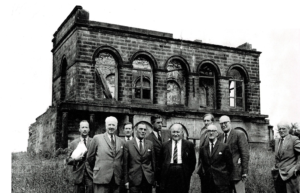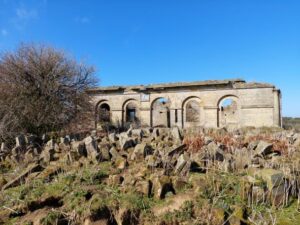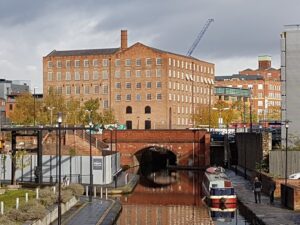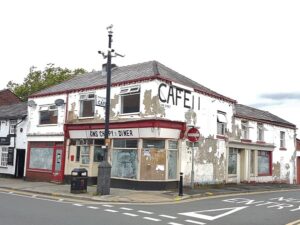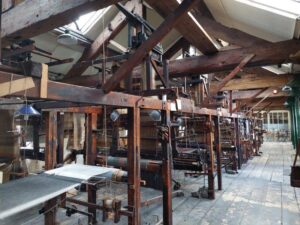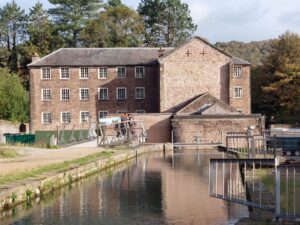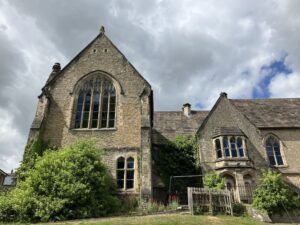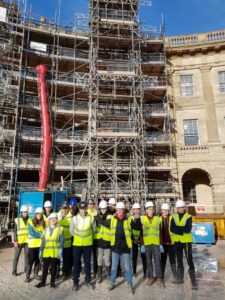This page provides examples of recent Creative Heritage projects commissioned by clients from the:
Private sector
The Old Grandstand, Richmond, North Yorkshire
CLIENT: RICHMOND BURGAGE PASTURES COMMITTEE
The former racecourse Grandstand in Richmond, North Yorkshire, was built in 1776 and is generally understood as being the work of architect John Carr of York. Richmond Grandstand is the earliest surviving stone grandstand in the country and is Grade II* listed for its special architectural and historic significance. The original use of the Grandstand ceased when Richmond Racecourse closed in 1891 and began to be used for annual military camps, exercising and training horses and other outdoor activities. From 1902-1941 the Grandstand was used as an isolation hospital until it was taken over by the military following the outbreak of WWII. After the war, the Grandstand was disused and suffered from vandalism and decay, which led to the partial demolition of the first floor of the Grandstand after being declared ‘unsafe’. Today, the Grandstand is a ruin, surrounded by salvaged stone, vegetation and a heras fence.
In order to find a solution for this building once and for all, Creative Heritage Consultants Ltd were commissioned by the property’s owners, Richmond Burgage Pastures Committee, to undertake an initial market analysis and feasibility study for the Grandstand and adjacent Zetland Stand. The work involved a condition survey and recommendations for repair, plus exploration of potential of end-uses in terms of need, demand and potential economic viability. We considered options such as facilities for Riding for the Disabled Association, an outdoor pursuits centre, a restaurant or café, holiday accommodation for the Landmark Trust or consolidation as a ruin with or without a viewing platform.
The report concluded that whilst holiday accommodation may be the preferred option in the long term, the best way forward for now is to consolidate the ruin, safeguarding the building and enabling the removal of the barrier fencing, until such time as the funding and conditions are right for a more active use.
The Long Barn, Whitle Fold, Derbyshire
CLIENT: PRIVATE INDIVIDUAL
The Long Barn is a Grade II listed building, dated 1671, originally used as a threshing and grain storage barn. It is located in the Whitle Conservation Area, an agricultural hamlet characterised by its architecturally simple farm dwellings surrounded by vast open countryside. The proposed development involves internal alterations and external alterations to the rear of the property, including a new window opening at ground floor, an additional rooflight and replacement of the existing two rooflights, all in conservation style.
Creative Heritage assisted with the design development by suggesting mitigation measures and produced a Heritage Impact Assessment. This led to successful planning and listed building consent applications, which were both approved by High Peak Borough Council in October 2024.
Bubnell Hall, Baslow
CLIENT: PRIVATE INDIVIDUAL
Bubnell Hall is a Grade II listed building situated in the Baslow and Bubnell Conservation Area and the Peak District National Park.
Creative Heritage Consultants were appointed in 2021 to produce a Statement of Significance which identified why the site is historically important, outlined the phases of development and suggested some design parameters to protect and reveal that significance.
In 2024, the owners re-approached Creative Heritage to produce a Heritage Impact Assessment to accompany a listed building consent application for the internal refurbishment of bedrooms and bathrooms. It was concluded that the proposals will have no impact on the significance of the listed building and will accommodate the needs of the current household. However, some further design development was suggested including methods of cleaning paint from the historic timbers.
Listed building consent was granted conditionally in June 2024 by the Peak District National Park Planning Authority.
Greatlow Farm, Hartington Upper Quarter
CLIENT: PRIVATE INDIVIDUAL
Greatlow Farmhouse is a Grade II listed building situated in Hartington Upper Quarter in the High Peak. The owners wish to repair and refurbish the farmhouse and bring it back into use as a dwelling. This will be the first phase of a wider project to conserve and reuse all the buildings within the historic farmstead.
Creative Heritage have been employed to develop a Heritage Impact Assessment for the farmhouse to assist the owners, their architects, and the planning authority, to reach a mutual understanding of the heritage value of the property and the potential impact of the proposals, in order to protect and reveal its historic significance. The farmhouse retains its historic roughcast render finish and exhibits typical details of eighteenth century Derbyshire vernacular buildings.
Listed building consent for repairs and minimal upgrading to create a livable dwelling has been granted by the local planning authority.
Brownsfield Mill, Ancoats, Manchester
CLIENT: URBAN SPLASH
We were pleased to work with architects StephensonSTUDIO and developer Urban Splash, as they developed a scheme for the residential conversion on this Grade II* listed former cotton spinning mill on the Rochdale Canal near Ancoats, Manchester. Originally built by the Leech family in around 1840, it is an excellent example of a well-preserved ‘room and power’ mill of ‘heavy-floored’ construction (using layers of thick floorboards rather than secondary joists between the floor beams). It is also significant on account of its completeness, its integral engine house, its internal mill chimney around which a spiral staircase winds, its split-level courtyard and its connection with AV Roe & Co, who built bi-planes inside the building in the early twentieth century.
The building was mothballed in 2008 by Town Centre Securities PLC, who undertook extensive repair of the external fabric and internal structure. Our Heritage Impact Assessment formed part of a successful application for planning and Listed Building Consent for conversion to generous loft-style apartments. The Assessment involved creating ‘datasheets’ for each proposed intervention, assessing the significance of the part of the building that would be affected, and the impact of the proposals on that special interest. The development was completed in 2019 and successfully marketed as Avro Lofts.
We continue to have a ‘retained heritage consultant role’ due to our in-depth knowledge of the building. In July 2025, we were reapproached by Urban Splash to provide heritage advice regarding an issue with a section of the roof, which was letting water in to one of the apartments. The architect’s initial proposal was to wrap the historic coping stones in lead, however after much discussion we advised them to reconsider a less intrusive repair, which did not require planning or LBC. Urban Splash has now appointed specialist contractors, Bullens Conservation, to carry out this repair.
Century Buildings, Birmingham
CLIENT: SARACENS CONSTRUCTION LTD
This study was commissioned by Saracens Construction Ltd to help them secure planning and listed building consent for a residential conversion scheme, including an apart hotel and apartments for sale.
The building has an interesting history and evolution of development, starting out as a late-18th century house, being extended to the rear with a workshop wing in the early 19th century and then being incrementally developed to the front and rear over the earlier part of the 20th century as the building evolved into commercial/industrial uses.
Creative Heritage produced a Heritage Impact Assessment which the Birmingham City Council Conservation Officer described as giving ‘thorough and detailed account of the historic development and evolution of the site and its place within the context of the development of the Jewellery Quarter. The various phases of development and alterations are clearly set out and well documented through map regression, historic plans and photographic evidence overall providing a sound assessment of the site and its significance’. The planning and listed building consent applications were approved with conditions in August 2024.
Voluntary sector
Tyldesley High Street Heritage Action Zone
CLIENT: FOR TYLDESLEY COMMUNITY INTEREST COMPANY
Creative Heritage provided project management services to For Tyldesley Community Interest Company, to support volunteer Directors and the wider community in the delivery of a High Street Heritage Action Zone. £1.5m was awarded by Historic England, which provided a grant pot for repairs to historic buildings on the main street of this former mining town, to the east of Manchester. Our role was to enable property owners to access grants for the repair of historic fabric and reinstatement of architectural features, such as traditional shop fronts.
We brought our extensive knowledge of Townscape Heritage projects to develop and implement grant administration and governance processes, and our experience of delivery of heritage skills training and community engagement projects. The project came to a close in March 2024, but For Tyldesley CIC continues to develop projects for the local community. For more information on the Tyldesley HAZ, please contact Ian Tomlinson: i.tomlinson@fortyldesley.co.uk
As part of this project, A Tyldesley Town Design Guide was developed, in response to comments about the high street put forward through an extensive community consultation. It provides advice on shopfront design, complementing the Council’s adopted Shopfront Design Guide. To view or download the Tyldesley Town Design Guide, click here. The appendices are in a separate volume, here.
Saving Macclesfield’s Heritage
CLIENT: THE SILK HERITAGE TRUST, MACCLESFIELD, CHESHIRE
Creative Heritage Consultants have been appointed as Project Managers to support the Silk Heritage Trust in the delivery of a package of repair and backlog maintenance works to safeguard the future of the Trust’s key assets, in light of the Covid-19 impacts. The buildings include the Grade II listed Silk Museum, Grade II listed Lower Paradise Mill, the top floor of which holds an astonishing collection of nineteenth century Jacquard silk hand looms, and the Grade II* listed Old Sunday School. £339,133 has been secured from the National Heritage Memorial Fund for these priority works, and associated fees and staff costs.
The Silk Heritage Trust were also successful with their application to the Arts Council Capital Investment Programme (Round 2), to create the Jacquard Studio accessible archive. Grant from the National Heritage Memorial Fund to replace defective air conditioning equipment, and from the Pilgrim Trust, provides match for this enhancement project, which will enable more people to use the historic Pattern Books as a creative resource. This work will be completed shortly and Creative Heritage continues to support the client to monitor progress and budget spend, and to submit final grant draw down applications.
The project presents the opportunity for us to bring our extensive project management skills and knowledge of industrial heritage projects – and it’s only half an hour from our office!
Cromford Mills: Celebrating Heritage, Creating a Sustainable Future
CLIENT: THE ARKWRIGHT SOCIETY LTD
Cromford Mills is a Grade I listed mill complex and is a key attribute to the Derwent Valley Mills World Heritage Site. It is from these buildings that Sir Richard Arkwright developed technology that changed the world we live in, giving rise to the industrial revolution by creating the modern factory system.
The Arkwright Society was successful in their Development Phase application to the National Lottery Heritage Fund for the sustainable redevelopment of Buildings 1, 7 and 8-10, which are currently on the National Heritage at Risk Register. Current plans include for the buildings to be transformed into a restaurant, visitor welcome area, office / holiday accommodation, and a new function and events space.
Creative Heritage Director, Kate Dickson, has been appointed as Client Project Manager to work alongside the Arkwright Society to procure and manage the design team and other consultants, and to deliver outputs that satisfy the requirements of the funders. Kate will also assist the Arkwright Society to develop and submit their Delivery Phase application to the National Lottery Heritage Fund, which is estimated to be in June 2027.
The Old Grammar School, Richmond, North Yorkshire
CLIENT: RICHMONDSHIRE BUILDING PRESERVATION TRUST
The Grade II listed Old Grammar School was designed by the renowned Victorian railway architect, George Townsend Andrews, and opened on 27th September 1850. It was known as the ‘Tate Testimonial’, having been built as a memorial to the famous past headmaster, Canon James Tate, who was in the post for 36 years. The building was used as a school until 2011, but since then it has stood vacant with limited maintenance.
Richmondshire Building Preservation Trust (RBPT) would like to repair and restore the Old Grammar School and create a centre for creativity and digital enterprise. Creative Heritage were appointed to support RBPT to develop and submit a Development Phase application to the National Lottery Heritage Fund under the Heritage Enterprise programme. This has involved working closely with RBPT to draft key supporting documentation, alongside working with sub-consultants to develop an accurate cost plan, project programmes, an activity and interpretation statement, valuation report, etc.
Sheffield Buddhist Centre, Low Carbon, High Karma
CLIENT: SHEFFIELD BUDDHIST CENTRE TRUSTEES
Sheffield Buddhist Centre would like to undertake a series of environmental upgrades to improve the thermal comfort and carbon footprint of the two listed buildings they occupy. Our role is to produce a Heritage Impact Assessment to support a planning and listed building consent application, and provide support with fundraising applications.
In August 2024, the Buddhist Centre’s application to the Low Carbon Community and Culture Fund (LCCC) was successful. This project, which is phase one of the ‘Low Carbon, High Karma’ project, involved installation of secondary glazing to the Great Hall gothic style windows, improved roof insulation and heating control upgrades. Works were completed end December 2024.
Phase two of the project, known as ‘Heritage Reborn’, will involve more extensive conservation repair work and environmental upgrades, including the replacement double glazed sash units, repair of the frames and urgent repair and maintenance works. In order to achieve this, Creative Heritage is supporting the Buddhist Centre in developing a National Lottery Heritage Fund application (for between £10,000 and £250,000).
Canada House, Sheffield
CLIENT: HARMONY WORKS TRUST CIO
Harmony Works CIO has ambitious plans to convert and extend Canada House in Sheffield City centre (originally built as the headquarters of Sheffield United Gas Company) into a home of inspirational music and opportunity, enriching and enhancing the lives of young people across the region. Following our previous involvement and due to our knowledge of the building, we were appointed to develop a Conservation Management Plan (CMP), to inform design development and support an application to the National Lottery Heritage Fund.
This involved understanding the building’s condition and significance, its management and maintenance needs, and future risks and opportunities. Our work also involved an in-depth survey of the building in order to produce detailed gazetteer sheets and develop a set of specific heritage policies. Harmony Works Trust submitted their National Lottery Heritage Fund application in August 2024 and were successful. In January 2025, they were awarded £4.7m from the Heritage Fund and £3.5m from the Arts Council. We can’t wait to see this project come to life!
Ron’s Place
CLIENT: WIRRAL ARTS AND CULTURE COMMUNITY LAND TRUST
Ron’s Place is a recently listed building (Grade II) on account of the unique artwork it houses. Kate Dickson has been appointed by the Wirral Arts and Culture Community Land Trust to provide heritage coordinator services to meet the requirements of an Architectural Heritage Fund Project Viability Grant.
Kate and Creative Heritage associate colleagues will work with the Trustees to clarify the vision and priorities for the project, develop the business case, strengthen governance and increase the investment readiness of the CLT. The outcome will be a project plan for the next stages of the project.
Public sector
Ashton-in-Makerfield and Leigh Town Centre Building Grant Schemes
CLIENT: WIGAN COUNCIL
Creative Heritage has been appointed to provide project management and architectural services to support Wigan Council in the delivery of two Town Centre Building Grant Schemes in the borough. Both are part of wider regeneration schemes funded with grant from HM Government.
In each case, the Building Grant Schemes aim to improve and regenerate the town centre by bringing out the best in the historic environment and helping to reinvigorate a sense of pride in the appearance of the town. A total fund of around £500k in Ashton and £1m in Leigh will provide grants to deliver a range of repair and conservation work to retail and other business premises, with a focus on upgrading shopfronts and refurbishing vacant space for occupation.
Kate Mitchell is our project manager on the ground until the end of March 2026. For more information about the Town Centre Building Grant Schemes, contact kate.mitchell@creative-heritage.net or see Ashton-in-Makerfield Town Centre Grant Scheme (wigan.gov.uk) or Leigh Town Centre Building Grant Scheme (wigan.gov.uk)
Buxton Crescent Heritage Skills programme
CLIENT: VINCI CONSTRUCTION UK, WITH BUXTON CRESCENT & THERMAL SPA LTD
We were delighted to deliver a number of heritage skills taster days at this very significant building conservation and regeneration project, to enable local people to gain an insight into the specialist skills being deployed.
Developed in conjunction with the main contractor, Vinci, the skills sessions for local building tradesmen, construction college students and Buxton homeowners, involved tours of the construction site to meet the specialist subcontractors engaged on the project. They offered a chance to handle traditional building materials and ask questions about the techniques being used to conserve this important grade 1 listed building.
The £52m project was funded by the National Lottery Heritage Fund, Historic England, D2N2, High Peak Borough Council, Derbyshire County Council and the private sector developer, Buxton Crescent and Thermal Spa Ltd. A short video of the first skills day for local building tradesmen was created by local media expert, Andy Parker, and provides an evaluation of this thoroughly enjoyable day.
Rediscovering the Underbanks Townscape Heritage Scheme
CLIENT: STOCKPORT METROPOLITAN BOROUGH COUNCIL
In 2018, Stockport Council was successful in its second stage bid for £1.79 million of funding from the National Lottery Heritage Fund. Funding was secured for a scheme that seeks to repair and reinstate key historic properties and their features in the Underbanks Townscape Heritage area, bringing them back into use to reanimate a once vibrant area. This project also has ambitions to rebuild gap sites, improve the public realm and create better links between the Underbanks, the modern Merseyway Shopping Centre and the historic Market Place.
Creative Heritage Consultants, and Associate Pete Brown, have been commissioned by Stockport Council to undertake a continuous evaluation of the Rediscovering the Underbanks Townscape Heritage Scheme. This involves critical review of the baseline methodology and background documents, creation of a logic model and evaluation framework for capital projects and the activity plan, annual project reviews to determine key lessons and a final evaluation study. Our work will track whether the scheme is meeting its objectives, guide strategic direction and identify good practice, and assess overall impact.
This project is due to be completed by May 2026.
Mentoring, monitoring and expert advice
CLIENT: THE NATIONAL LOTTERY HERITAGE FUND
Kate Dickson has been a member of the National Lottery Heritage Fund’s Register of Support Services since 2012. In this consultancy role, she has mentored a wide range of organisations undertaking heritage projects, including:
- Derbyshire Historic Buildings Trust – governance support to reinvigorate dormant organisation and mentoring during early stages of the Trust’s Wingfield Station project.
- The Highlife Centre, Coventry – exploring how to build capacity for heritage projects within the Black African community in the Midlands.
- St Peter’s, Haveringland, St John the Baptist, Nash, Crostwight Church, Norfolk, St Mary’s, Wirksworth – repair and community engagement projects.
- Re-Form Stoke-on-Trent – resilience funding to develop the organisation as a Heritage Development Trust and increase viability of the Middleport Pottery visitor attraction.
- Watford Heritage Hub – major refurbishment of listed 1930s Town Hall to accommodate Watford’s Museum and Heritage Service.
- Woodoaks Farm, Soil Association Land Trust, Black Barn Project.



